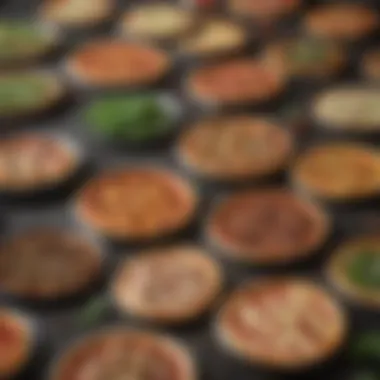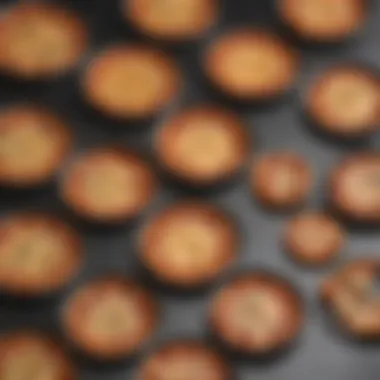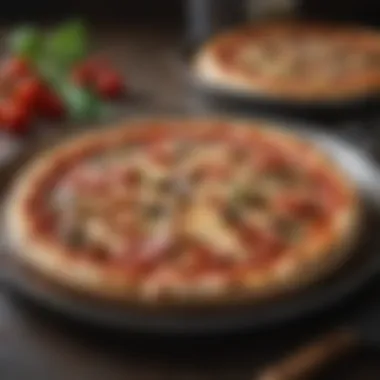The Importance of Choosing the Right Pizza Pan


Intro
Choosing the right pizza pan can significantly affect the final outcome of your pizza. This guide delves into the essential aspects of selecting an appropriate pizza pan, such as material, size, shape, and maintenance. By understanding these elements, pizza lovers and cooking enthusiasts can enhance their overall pizza-making experience. A good pan not only helps in baking an evenly cooked crust but also ensures that your pizza develops the desired texture and flavor.
The Importance of a Good Pizza Pan
The selection of a quality pizza pan goes beyond mere preference; it impacts texture, baking time, and even flavor.
A high-quality pizza pan is crucial. Many types exist—each with unique characteristics that influence not just the baking process but also the inherent qualities of the pizza itself. Factors like heat distribution, browning, and ease of handling during baking ultimately determine both the flavor profile and texture of your finished dish. Furthermore, by maintaining the pan properly, you can prolong its life and maintain consistent results with your cooking efforts.
Key Points of Discussion
In this article, we will address several key points relevant to understanding good pizza pans:
- Material: Understanding how different materials affect cooking processes.
- Size and Shape: The variety of available sizes and the impact of shape on the final result.
- Types of Pans: Overview of various pizza pans, including ceramic, cast iron, and non-stick varieties.
- Cooking Techniques: Best practices for baking and maintaining your pizza pan.
- Personalization: How specific choices can enhance or complicate pizza-making.
Materials Matter
The choice of material is significant when it comes to pizza pans. Each option offers different heat conductivity and moisture retention properties. Common materials include:
- Aluminum: Lightweight, excellent heat conductivity, and affordable.
- Cast Iron: Heavy, great heat retention, ideal for achieving a crisp crust.
- Ceramic: Offers aesthetic appeal; retains heat for even baking but may have a longer preheating requirement.
- Non-stick Coating: Eases cleanup and initial pizza removal but can wear down over time.
Each material affects how your pizza will rise, brown, and cook. Making an informed choice is vital.
Concluding Thoughts
Foreword to Pizza Pans
A pizza pan is a fundamental tool in the pizza-making process. Its importance cannot be overstated. The quality of a pizza pan affects various aspects of the preparation and baking of pizza, significantly influencing the final product's taste and presentation.
Understanding pizza pans is essential for anyone who enjoys making or eating pizza. A well-chosen pan brings numerous benefits. It can improve heat conductivity, promote even baking, and enhance the crust's texture. Different styles of pans serve varied purposes, from traditional round designs to rectangular options. As preferences evolve in making pizzas, understanding the distinctions between these pans, and their roles in the baking process, is fundamental.
Additionally, flattering the experience of creating pizza from scratch means considering how while materials differ, they can greatly impact performance and durability. Selecting the right type of pan requires thoughtful consideration and awareness of personal taste preferences and cooking habits.
Why Pizza Pans Matter
Pizza pans matter because they are integral to baking a perfect pizza. A good pizza relies on finding the right balance between the crust's crispiness and the toppings' moisture. Each pan type contributes differently to this dynamic.
For instance, metal pans heat rapidly, making them suitable for those who prefer a quick bake. In contrast, stone pizza pans offer a more robust thermal mass, allowing for gradual heat absorption, ideal for achieving that sought-after crispy base.
In a world flooded with pizza options, knowing which pan to use can elevate your cooking game. Getting the pizza out of the pan can be easy or hard based on its material and design - the ease or difficulty can affect the presentation and enjoyment.
The Role of a Good Pizza Pan
The role of a good pizza pan extends beyond mere functionality. It serves as a foundation for your pizza creations. A high-quality pan ensures that the pizza is cooked uniformly. Undercooked or burnt sections ruin an otherwise great dish, establishing the importance of choosing wisely.
In practical terms, a pizza pan helps distribute heat evenly across the crust, reducing hot spots. A well-designed pan promotes browning and crisping, a illustrious goal in pizza making. For individuals exploring their culinary skills, investing in a dependable pan contributes to a more enjoyable activity.


Overall, the right pizza pan can reinforce desired characteristics in your pizza, such as thickness and flavor. Underestimating this tool could diminish your pizza experience, leading to inconsistent results.
Deciding on a pizza pan brings you closer to reaching your flavorful aspirations and memorable meals with loved ones.
Types of Pizza Pans
Pizza pans can significantly influence the end product of any pizza. Different types come with advantages and peculiarities that impact not just the pizza's taste but also its texture and the ease of making it. Understanding the types of pizza pans provides insight into methods of baking that maximize flavor and quality. This section delves into various types, highlighting their pros and cons.
Metal Pizza Pans
Aluminum Pans
Aluminum pans are lightweight and known for their excellent heat conductivity. They heat up rapidly, ensuring that a pizza is cooked evenly and thoroughly. This is critical when trying to achieve a crispy crust without burning other parts.
One main feature of aluminum pans is their reflectiveness, which helps color the crust while baking. Because of their low cost and ease of use, aluminum pans are typical in many homes. However, a disadvantage can be that they can scorch your crust if you are not careful. Proper monitoring when baking is necessary, during this preheating phase and beyond.
Steel Pans
Steel pans are another popular choice among pizza enthusiasts, distinguished by their durability and superior heat retention. They often create a superior crust due to their ability to sustain high temperatures over longer periods.
A characteristic feature of steel pans is their weight, which helps provide an even baking surface. Though they are typically heavier and may require more care when washing to prevent rust, steel pans give an advanced chef or home baker a chance to obtain an authentic pizza experience. One downside is that they also preheat slower than aluminum pans.
Stone Pizza Pans
Cordierite Stones
Cordierite stone pizza pans are favored for their natural contribution to the baking process. Cordierite's heat retention ability allows it to emulate the effect of a pizza oven more closely. This makes it an excellent choice for achieving a particular flavor profile.
One of the significant traits of cordierite is its ability to hold moisture, enabling a crispier crust. Pizza lovers often seek out this type of stone because it mimics traditional pizza stones used in commercial pizza ovens. The only disadvantage is that cordierite stone pans can require careful thermal management to prevent cracks.
Ceramic Stones
Ceramic stones, on the other hand, are made from baked clay and are sought for their aesthetic appeal and good thermal properties. They are quite heavy, providing an even heat retention, resulting in moist interiors and crispy surfaces. Also, ceramic stones can be used to bake non-pizza foods successfully, further increasing versatility. The color of many ceramic stones adds to the ambience during serving.
However, storage can be challenging due to the fragility of ceramic pans, leading to chips or cracks. Thus, they must be handled with care to avoid breakage in kitchens that may not prioritize gentle treatment.
Cast Iron Pizza Pans
The cast iron pizza pan is a time-tested option. Cast iron boasts superior heat retention and evenly baked crusts. Similar to skillets, they can often go from stovetop to oven without issue. Pizzas in cast iron pans are known for developing a particular crunchy texture—achieved from preheating the pan beforehand.
One characteristic that stands out is how down the flavors of ingredients merge through cooking your pizza directly in cast iron. Many cooks appreciate this type for its durability, perfect for pizzerias or enthusiastic bakers who requier tough tools. One may have to be cautious with sustainability, especially after washing to avoid rust.
Non-Stick Pizza Pans
Non-stick pizza pans simplify the baking process. The non-stick surface eases the transfer of pizzas and ensures that nothing sticks to the base. Beginners often gravitate toward these for the confidence it brings in unloading their regularly shaped пап with well-defined edges.
Alle offering easy cleaning and maintenance to boot, they are popular for their practicality. Nonetheless, viewers should note they may not generate the crispiest crust compared to aluminum or steel pans. Heat may be distributed less aggressively than metal options.


Pizza Steel
Pizza steel brings a contemporary twist on traditional stone or metal pans. It provides intense and superior heat transfer, enabling crusts to achieve a pizzeria-style snap. The opportunity to preheat for more extensive time frames allows results akin to commercial pizza ovens.
A point that attracts individuals to pizza steel is the reduced preparation time. You achieve incredible flavor and texture within minutes than other options, appealing to the modern cook. However, due to its weight, it can be cumbersome to handle for daily use.
Factors to Consider When Choosing a Pizza Pan
Choosing the right pizza pan is essential for anyone serious about pizza making. Different factors influence the final result of baked pizza. When surveying the options, it is important to recognize how material, size, shape, and maintenance all come into play. Each feature affects pizza differently, hence putting emphasis on these points will empower buyers to invest themselves wisely.
Material and Durability
The material of a pizza pan significantly affects its durability and performance. Different materials possess unique characteristics, affecting heat retention, baking time, and flavor.
- Metal Construction: Aluminum and steel are common choices due to their excellent heat conductivity. Aluminum pans are lightweight and presilevel heat evenly, and they are suitable for high temperatures. Steel pans are sturdier and have a longer lifespan.
- Stone and Ceramic: Stone pizza pans are favored for their ability to mimic wood-fired ovens. The heating properties of stone make them great for achieving innovative crust qualities. Ceramic pans, while aesthetically pleasing, require more cautious handling due to fragility.
- Cast Iron: This type is highly durable and retains heat well, making it great for a crispy crust. However, it can be subject to rust if not maintained properly. Non-stick variants are also available, providing an alternative for those seeking an easy clean.
Ultimately, the quality of the material influences both the long-term investment and the pizza experience itself.
Size and Shape
The dimensions and configuration of a pizza pan can dictate much of the overall baking experience. Pizza comes in varying sizes and profiles; thus, selecting an appropriate pan is crucial.
- Standard Sizes: Common sizes, like 10-inch or 14-inch, usually resonate with household needs. Larger sizes accommodate family-style pizzas while smaller pans are great for individual servings.
- Shape Considerations: Round pans are traditional but rectangular or square styles may yield better fitting in the oven. Additionally, the edges vary, affecting the aesthetics of the crust.
Choosing the right size and shape will facilitate a well-cooked pizza type, considering personal preference for thickness and dimension.
Heat Conductivity
Heat conductivity plays a pivotal role in the baking process. Pans with excellent heat distribution produce the desired outcome in crust and toppings.
- Quick Bake: Materials such as stainless steel evenly conduct heat, promoting quick baking, which is key for achieving that Urgent crunch.
- Slower Bake: Stone or cast iron pans generally give the pizza more time to cook. They hold heat longer, helping evidentough flavors permeate deeper into the crust.
In this aspect, personal preference features prominently, which makes aware testing necessary for efficient gathering of results.
Ease of Cleaning and Maintenance
After the delicious process of making pizza, the time spent cleaning can overshadow the enjoyment. Hence, how easy a pizza pan is to clean should not be underestimated.
- Non-Stick Coatings: These facilitate hassle-free cleaning scenarios. Regular annihilation of baked-on food without spending excessive amounts of time is achievable.
- Material Choice: The durability of materials plays a role here. Metal pans do well under scrubbing but cast iron needs seasoning. These considerations will drastically alter post-cooking interactions and overall cleanliness of kitchen ware.
- Long-term Care: Routine maintenance ensures pizza pans deliver consistently over years. Proper knowledge coupled with techniques discussed will yield a memorable baking journey.
Conclusion: Each factor contributes significant dimensions to pizza making. Understanding them leads to better choices. Taking time surveying options should equate to creativity in the kitchen as well as ensuring lovey fresh pizza delights.
How a Good Pizza Pan Affects Baking
The choice of pizza pan is a crucial consideration when one seeks to achieve a high-quality baking result. A good pizza pan not only aids in cooking but also enhances texture and flavor. Different pans have varying influences on these facets. Understanding the distinct functions of a pizza pan provides insight into creating the best homemade pizza experience. Expansion on three main areas elucidates how the right pan can made a notable impact: heat distribution, crust texture and flavor, and cooking time.
Heat Distribution


Heat distribution refers to how evenly heat is spread across the surface of the pizza during baking. An effective pizza pan allows heat to circulate properly. This quality ensures that the pizza absorbs heat effectively, enhancing the overall cooking process. Metal pans, such as aluminum and carbon steel, are known for superior heat conduction. They tend to heat up rapidly and maintain consistent cooking temperatures. Conversely, some stone pans get very hot, leading to intense conduction, which is ideal for those looking for perfectly crisp crusts.
- Uniform heat: A well-designed pan ensures pizza cooks evenly without hotspots.
- Temperature maintenance: Pans that do not warp or shift objects effectively hold temperature for longer.
Crust Texture and Flavor
Crust texture significantly influences the eating experience of pizza. Good pizza pans enable you to achieve the desired crunch or softness in the crust. Within this context, materials play a vital role. A cast iron pizza pan enhances the crust's flakiness thanks to its ability to hold heat for prolonged periods, developing beneficial browning. Stone pizza pans benefit from their porous surfaces which absorb moisture, giving the crust a bakery-quality texture, deep flavor, and attractive appearance.
- Crispness: Properly chosen pans assist in achieving a satisfying, crispy edge around the pizza.
- Flavor profile: Different materials impart flavors based on the cooking method used.
Cooking Time
Cooking time can vary based on the pizza pan employed. Some pans, like those made from lightweight aluminum, tend to expedite cooking. In contrast, thicker materials may require a longer duration but could yield superior end results as the pizza develops better structure and flavor. Notably, even the shape of the pan influences the overall time.
- Shape significance: Round pans typically allow for an even bake. On the other hand, square pans might conserve heat differently.
- Pan lifespan: Quality material pans reduce unwanted warping over extended cooking, leading to a more stable cooking experience.
A good pizza pan is not merely a cooking utensil; it is the silent partner in creating extraordinary pizzas.
Ultimately, the repercussions of selecting a good pizza pan extend into how dense, airy, crisp, or soft the final product may be. When you consider factors like heat distribution, crust texture, and cooking time, achieving excellent pizzas becomes entirely possible.
Maintaining Your Pizza Pan
Taking good care of your pizza pan is vital in ensuring its longevity and effective performance. The significance of maintaining your pizza pan extends beyond just keeping it clean; it directly impacts the quality of your pizzas. A well-maintained pan provides consistent heat distribution during the baking process, allowing for even cooking, which is important for achieving the perfect crust.
Additionally, neglecting maintenance can lead to residue buildup and deterioration, both of which can affect the flavor and texture of your pizzas. It is wise to invest a little time and effort into preserving your pizza pan. The longevity of your pizza pan begins with two key considerations: cleaning techniques and correct storage recommendations.
Cleaning Techniques
The cleaning methods you choose can have lasting effects on the surface and effectiveness of the pan. Cleaning a pizza pan needs to be done carefully, as aggressive cleaning tools or harsh chemicals can damage the non-stick surface or material itself. Start by allowing the pan to cool completely before Any form of cleaning to avoid warping or thermal shock.
When it comes to gentle yet effective cleaning, here are some practical techniques:
- Soaking: If you have leftover grease or food particles, let the pan soak in warm, soapy water for about 15-30 minutes. This softens stuck-on bits for easier removal later.
- Using a Soft Sponge: Always use a soft sponge or cloth. Avoid abrasive pads that can scratch the surface. A non-abrasive scour pad will help you get rid of stubborn stains without compromising the integrity of the pan.
- Baking Soda Paste: For tougher stains, mix baking soda with a little water to form a paste. Apply it to the stained areas and gently scrub with a soft sponge. Baking soda is a natural abrasive that avoids damage while effectively removing stains.
- Drying Properly: Ensure the pan is thoroughly dried after washing. Leftover moisture can cause rust, especially in materials such as cast iron.
Storage Recommendations
Proper storage increases the lifespan of your pizza pan as well. When not in use, it’s important to store the pan in a way that makes it safe from scratches and environmental factors.
Consider the following storage methods:
- Stacking Carefully: If you have multiple pizza pans, stack them inside each other but place a paper towel or cloth between each pan. This provides a buffer and prevents scratches.
- Hanging Options: If you have space, consider hanging your pan on a wall hook. This method keeps it accessible and protects it from scratches.
- Avoiding Nesting with Other Use Items: Do not store your pizza pan with heavy items on top as this might warp its shape.
- Dry Area: Always keep your pan in a dry location. Humidity can cause rust or damage to specific types of pans like cast iron
Maintaining your pizza pan starts with understanding the cleaning techniques and following suitable storage practices. This can enhance the baking experience and the quality of your overall pizzas.
Epilogue: The Right Choice for a Delicious Pizza
Selecting the right pizza pan is an essential step toward achieving a delicious home-cooked pizza. Every detail contributes to the final result. From the material of the pan to its size and shape, each choice influences the baking process and ultimately the pizza experience.
To summarize, consider the following points when choosing a pizza pan:
- Material Matters: Different materials interact in distinct ways with heat. For example, aluminum pans offer great heat conduction, while stone pans require more time to heat but produce a crispy crust.
- Size and Shape: The size of the pan can determine the thickness of the dough and how long it cooks. A larger pan spreads heat evenly, while a smaller one may lead to uneven cooking.
- Heat Conductivity: Effective heat conduction allows for optimal baking. Non-stick pans may make for easier removal, but some might retain heat better than others.
- Maintenance: How you clean and store your pan has long-term implications for its performance. Regular maintenance keeps your pan in good condition and preserves the flavors it helps to create.
The analysis in this article not only highlights these dimensions but also facilitates your understanding, enhancing your pizza-making journey. Without establishing these preferences, you risk producing subpar results that do not meet your gastronomic expectations.
An excellent pizza pan is an investment in your culinary experience, capable of elevating every meal.







